Spherical Geometry - Definitions
Created | Updated Sep 8, 2014
Most geometry is plane geometry - it takes place on a flat surface, and is therefore easy to solve using diagrams. However, the world we inhabit is not flat (although this theory was popular at some point in our history), but round. Although the Earth is not exactly spherical, geometry on a sphere is a good starting point for many real-world applications.
Things are not completely straightforward when we are dealing with spherical geometry. In order to make sure we understand each other, we need to define a few concepts. In plane geometry they are intrinsically obvious - not so on the sphere!
The Sphere
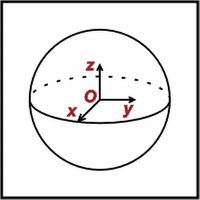
Before anything else, we need to be certain we understand what is meant by the sphere. Many applications of spherical geometry will utilise a co-ordinate system - three variables which can uniquely identify any point in the given space. The three variables are usually x, y and z, so a point in a 3-dimensional space would be notated (x,y,z), for the relevant values of x, y and z.
For ease of calculations, we position our sphere so that it is centred on the 'origin' (the point where all the variables are zero - (0,0,0)). The sphere itself now consists of all points satisfying the equation:
x² + y² + z² = r²
where r is the radius of the sphere. For convenience, a radius of 1 is often used. Notice that by this definition, the sphere is just the 'surface' - it is a hollow sphere. To emphasise this, we sometimes refer to 'the surface of the sphere'.
Lines
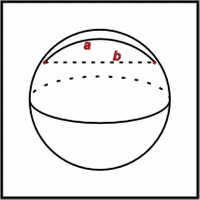
As in plane geometry, a line-segment on a sphere is the shortest 'line' connecting two points - over the surface of the sphere. This is not the same as the shortest line-segment joining the two points in regular three-dimensional space. The former is a curve in three-dimensions, while the latter is 'straight'.
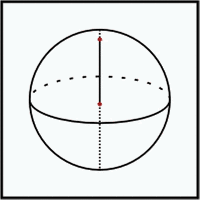
It should be clear that this line-segment will appear straight if viewed from a point directly above any point of the line-segment. Think carefully about what this means - in its strictest sense, 'directly above' the sphere means a point outside the sphere, looking towards the exact centre of the sphere. Now imagine extending the 'straight' line you see to the 'edges' of the sphere, as if cutting it in two.
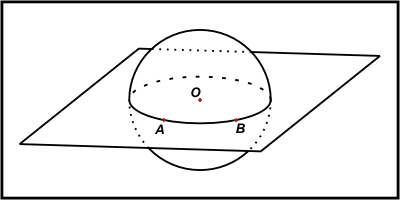
This is the same as if we were to bisect the sphere, using a plane which contains both endpoints of our original line-segment, and the origin (centre of the sphere). So the maximum 'extension' of a line-segment (and therefore our line) is a circle, with the same radius as the sphere. This is known as a great circle, as it is the largest circle it is possible to draw on the sphere.
Using the above notation, three easily-defined lines are ones with one co-ordinate equalling zero. The general equation for a circle is a² + b² = r² - putting any one of x, y or z equal to zero in our equation for the sphere will clearly reduce it to this form.
Antipodal
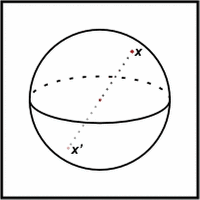
Two points on the sphere are said to be antipodal if they both lie on the same (3-dimensional) straight line through the origin. The North and South Poles make a good 'real-world' example. In a sense, antipodal points lie opposite each other.
Notice that two great circles will intersect in two points on the sphere - these two points will always be antipodal.
Angles
Imagine two great circles on the sphere. Choose one of the two points where they intersect. The angle between the two lines is then defined to be the angle between the two planes formed by the great circles.

There is an equivalent, and perhaps easier to understand, definition. Imagine a flat, transparent plane which just touches the sphere at the point we wish to measure our angle. If we look at the plane from directly above the sphere, the lines on the sphere will appear straight on our plane. The angle between our spherical lines is then the angle between the corresponding lines on the plane.
However, remember that we use radians (rather than degrees) to measure angles. 2π radians = 360°.
We may write the angle between lines OP and OQ as PÔQ.
Distance
It might seem unusual to define angles before we define distance. We do this because on the sphere, it makes sense to define distance in terms of certain angles.
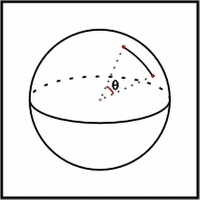
Imagine two points A and B on the sphere. The distance d(A,B) between them is length of the shortest line-segment which connects them. Because of the way we defined lines, this line-segment must be an arc of a great circle. Joins our points A and B to the origin of the sphere, to create a 'wedge' shape. We can measure the angle at the origin - call it θ. The length of our arc is then rθ.
Notice that if r = 1, we have d(A,B) = θ.
Triangles
A spherical triangle (notated ΔPQR) consists of three vertices (P, Q & R), and three line segments (arcs of great circles) PQ, PR & QR which join them. Note that the lines do not have to be the shorter arcs. Also, if any two points are antipodal, we must specify which great circle to be the arc joining them (as there are an infinite number of great circles containing both points).
Isometry
In plane (or 3-dimensional) geometry, an isometry (sometimes called a motion) is a map1 which conserves distance. That is, the distance between any two points will remain unchanged by the map. In 3-dimensional space, an isometry must be one of:
- A rotation (about a given axis)
- A reflection (in a given plane)
- A translation (by a given distance in a given direction)
- Some combination of any number of reflections, rotations and translations
The same holds true on the sphere. However, since we are restricted by the fact the that the sphere must be mapped to the sphere, the list of possible isometries is reduced to:
- A rotation (about a given axis which passes through the origin)
- A reflection (in a given plane which contains the origin)
- Some combination of any number of reflections and rotations
Notice that we may not have a translation on the sphere.
So What Now?
When we use any of the terms above, we can be sure of what we mean, and what others will mean by them. Equipped with these definitions, we are now ready to tackle to subject of spherical geometry.
If this entry has left you totally baffled, why not let the Beeb help you swot up on your maths with BBC Learning?

